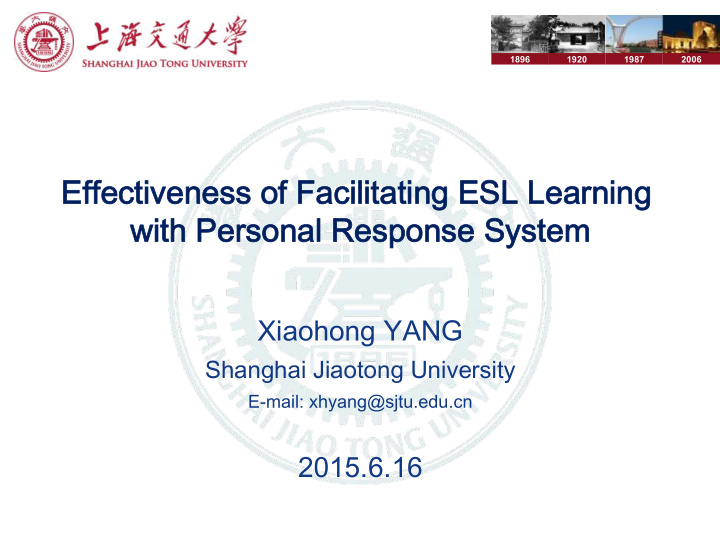



1896 1920 1987 2006 Effectiveness of Facilitating ESL Learning with Personal Response System Xiaohong YANG Shanghai Jiaotong University E-mail: xhyang@sjtu.edu.cn 2015.6.16
Contents • Introduction 1 • Complementation 2 • Results and Discussion • Conclusion 3
Introduction 1896 1920 1987 2006 Research Background Ø Literature Review: infancy (Shapiro, 2009; Educue, 2003; Birdsall, 2002 ) Ø Learning problem: efficiency Ø Institutional support: CTLD of SJTU
Introduction 1896 1920 1987 2006 Theoretical Framework Ø Peer Instruction (PI) Eric Mazur. Peer Instruction: A User’s Manual [M]. NJ: Prentice Hall, 1997. Ø The Zone of Proximal Development (ZPD) Vygotsky,1978
Introduction 1896 1920 1987 2006
Implementation Participants 35 First year postgraduate students Period one term Tools Employed • Questionnaire • Interview • Writing Test • Students writing of journal
Imple lementat ation on� Te Teach aching A g Act ctivity D Design gn • At Term Beginning ==》purpose : placement and warm-up • In the midst of Term ==》purpose : intensifying and promoting • At Term End ==》purpose : summary and reflection
Learning Background Survey(1) �������������������������������1����� ������ ����������� 70%& 59.3%& 60%& 50%& Vocabulary& 40%& Grammar& Content& 30%& 22.2%& Organiza@on& 20%& 11.1%& 7.4%& 10%& 0%& Vocabulary& Grammar& Content& Organiza@on&
Learning Background Survey(2)
Implementation Highlights of Knowledge and Skills Essay structure Sentence structure Logic thinking Wording Rhetoric Punctuation Proof-reading …
Writing Good Sentences Yang XH Shanghai Jiaotong University xhyang@sjtu.edu.cn
Implementation Learning Procedures Step 1 Students viewing of teaching slides (before class) Step 2 Students 1 st voting for questions designed Step 3 Students discussing and debating with peers Step 4 Students 2nd voting for the same questions Step 5 Teacher’s explanation and extra materials provided
Implementation A case study Learning about punctuation Question: Which of the following sentences is wrong grammatically? A) It is fine, we go outing. B) It is fine, so we go outing. C) It being fine, we go outing. D) It is fine; we go outing. E) Since it’s fine, we go outing.
Implementation Key: A
Results and Discussion Raised Performance 5 writing tests: An increase in test scores Student Evaluation of PRS Likert scale rating Interviews both individual and collective Students journal writing
Table 1 Writing Test Results (Full score: 20) Student Test 1 Test 2 Test 3 Test 4 Test 5 Note No. (GROUP) 1 CAI 12 15 14 14 16 G1 2 FU 17 18 18 18 17 G2 C 3 WANG 7 7 8 10 16 G1 4 FAN 9 8 9 15 16 G5 5 HE 15 17 17 19 18 G3 C 6 LI 14 14 15 16 18 G3 7 YOU 13 14 15 15 18 G3 8 ZHANG 14 15 15 17 17 G4 C 9 WU 13 16 15 18 16 G1 10 CHEN 13 15 14 17 17 G4 11 JIANG 11 11 13 16 17 G1 …
Table 2 Results of Student Evaluation Likert scale Mean Questions 1 I participate more in class because PRS is used. 4.12 2 I try my best to get the right answer to PRS questions. 4.34 3 I gets me more involved in communication with others in the PRS course. 4.25 4 PRS helps me to learn better course materials. 3.37 5 Given the chance to select, I prefer a PRS course to a non-PRS course. 3.90 6 PRS helps me in identifying my problems in learning. 3.87 7 I have difficulty in understanding the PRS questions. 1.76 8 It takes me time to get used to PRS courses. 1.54 Likert scale : 1= strongly disagree; 2= disagree; 3= neutral; 4= agree; 5=strongly agree
1896 1920 1987 2006 Conclusion Effectiveness u Encouraging contact between S & T u Developing productive interaction and cooperation among students u Promoting Active Learning u Raising learning interest u Easily knowing who knows what …
1896 1920 1987 2006 Conclusion For future study Ø Key: question designing Ø Flexibility in use : conceptests Ø Frequency of use: at intervals
Thank you!
Recommend
More recommend